Aiming High: Five MHS Engineering Students Make a Run at 2016 Rocketry Challenge National Finals, Earn Berth at 2017 NASA Student Launch
The McKinney High School Flying Lions Rocketry Team tackled the Team America Rocketry Challenge for the first time in 2016.
McKinney, Texas – With a storm rolling in and conditions deteriorating rapidly, Mitchell Palmer adjusted his grip on the umbrella and held it out away from his body to shield the small rocket his teammates were urgently attending to.
The Flying Lions from McKinney High School sat in second place going into the final round of the Team America Rocketry Challenge national competition on May 14. They’d bested some 700 other teams from across the country to get here. Now, they had 24 remaining teams to beat and one more launch to do it.
The first launch had gone almost perfectly, landing them at second in the standings.
But, the weather had shifted dramatically, and that had to be accounted for. Rain and wind meant excess drag, and drag would affect their altitude and their allotted time window.
They were on there own here. No help would come from coaches or mentors.
The rules were very specific. This miniature rocket, laden with two raw eggs, had to climb to an altitude of 825 ft. and return its contents to earth, unharmed, within a span of 44 – 46 seconds. Cracked eggs meant disqualification.
The team wasn’t worried about that. The protection system they’d designed was practically flawless. Their eggs had survived a complete malfunction during a test launch, had been recovered virtually unscathed after the rocket crashed to the ground.
Altitude and time were the primary concern. Deviation from the mission parameters—above or below the time window and altitude—meant added points, and the TARC teams didn’t want points. Victory was awarded to the team with the score closest to zero.
The storm was coming. They had to go.
Eric Beights, William Slater, Kathryn Lehocky, Alex Lehocky and Mitch Palmer stepped away from the rocket and signaled to the judges that they were ready to launch.
It was now or never.
Ignition.
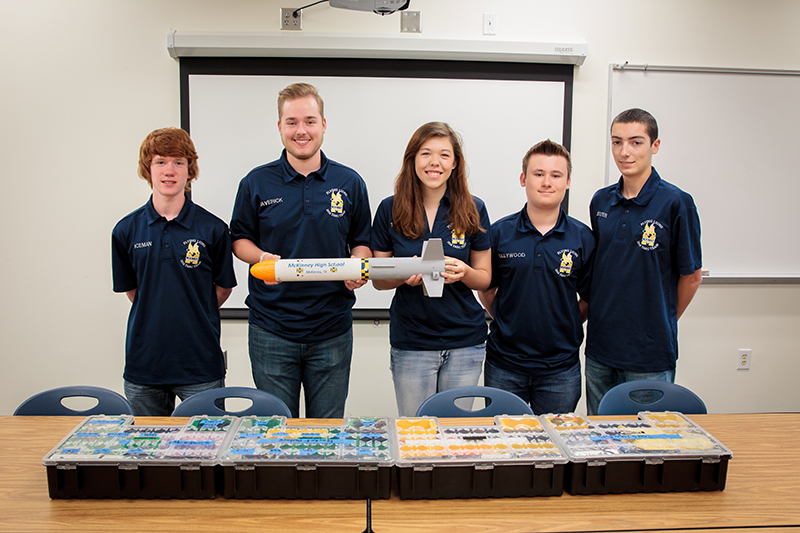
The MHS Flying Lions 2016 TARC Team (l-r): Eric Beights, William Slater, Kathryn Lehocky, Alex Lehocky and Mitch Palmer
Launch
“It was basically my uncle that got us into this. Her dad,” said Alex Lehocky gesturing toward his cousin and teammate Kathryn Lehocky.
“I had just joined the engineering program at MHS this year,” explained Kathryn, “and I got into the Technology Student Association (TSA). I started doing a smaller rocket competition and so my dad, who’s an engineer, was really excited about that, and he started looking around, and he found this TARC competition. So, when I got really interested in it, we talked about it with [MHS engineering teacher Robert] Gupton and we basically just started looking for other people who were also interested in joining the competition with us.”
Originally, ten volunteered, but over time, that number narrowed to the five brilliant kids who would take a rocket to Washington, D.C. and the national finals: four juniors—Kathryn, Alex, Eric and Mitch—and a senior, Will. All products of the MHS engineering program.
Stephen Lehocky, dad and uncle to Kathryn and Alex respectively, would serve alongside Gupton as mentor to the team.
But, due to involvement in other competitions, the team was late getting into the game. Where many TARC teams spend a year building and testing their rockets, the Flying Lions from McKinney High School, had only about 5 months to prepare.
That created a supply problem.
“Most of the rockets out there are powered by one F motor,” said Will, “and whenever we started to buy the engines we needed, all the F motors were out of stock, so we had to go to a cluster of four D motors.”
Undaunted, they began work on a design that would utilize the four smaller motors rather than one large one. The team worked tirelessly, logging hour after hour outside of school, designing parts and fabricating them on 3-D printers.
“We were the only team with 3-D printed parts,” said Alex.
They created nosecones and internal brackets and an engine mount—and variations on each one as they swapped pieces in and out of their modular design until they had the ideal rocket.
“We had a bunch of different fittings,” said Will. “We had a lot of bottom sections in case things broke. At least 12 different nosecone renditions.”
The Flying Lions put in hundreds of hours of work, obsessing over the details, intent on getting everything perfect. “Our entire spring break was building rockets from sunup to sundown,” said Will. “You go in thinking, ‘Oh, I’ll work for five hours today,’ but then you start working and you get the bug and you just have to keep working on it more and more and more.
“We were getting the first design of our rocket done. So, it was still a lot of design. Kat and I built pretty much the first rendition of the rocket. A lot of it isn’t here in the present rocket, but it was the basis of what it was all built off of.”
“I think we worked until almost midnight one night,” added Kathryn.
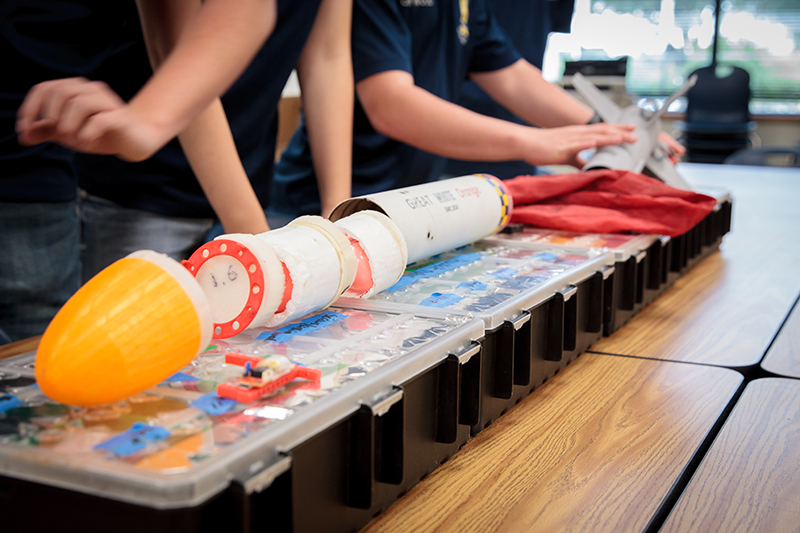
The team from MHS created interchangeable pieces, such as nosecones and brackets, using a 3-D printer, an approach which allowed them to easily swap out components as they tested their design ideas.
Soar
The qualification deadline came quickly, and the team only managed four or five test launches before they had to make it count. “We could do three launches, and they took the best two and based on those two, they decided the top 100 teams [in the country] that get to go to nationals,” said Eric.
The first qualifying launch was a decent effort, and they came away with 14.21 points. Launch number two resulted in a separation—a disqualified flight.
“Our third was our best,” said Eric. “It was really good. We got a score of 1.16. That’s the best launch we’ve had, and it was good enough to get us to nationals.”
The team was elated. And feeling pretty confident.
Gupton added some perspective on their qualifying launch. “The scores they got in qualifying would have actually won the national championship last year,” he said.
Now that they were in the national contest there was still much work to be done. There were more test launches—30 – 35 of them at about $25 a pop. The Engineering Booster Club kept them afloat.
Some attempts were more promising than others. “We’ve been attacked by our rocket before,” said Kathryn. “It feels really great when the rocket gets in the air. That’s the most uplifting part.”
“But, because we use multiple engines, if one of those doesn’t ignite, it’s going to go at a steep angle. During one launch only one of the motors lit for some reason, but it was enough for it to get off the launch rod, and it just started flipping in the air toward us,” she said.
But, even the failures provided clues to success.
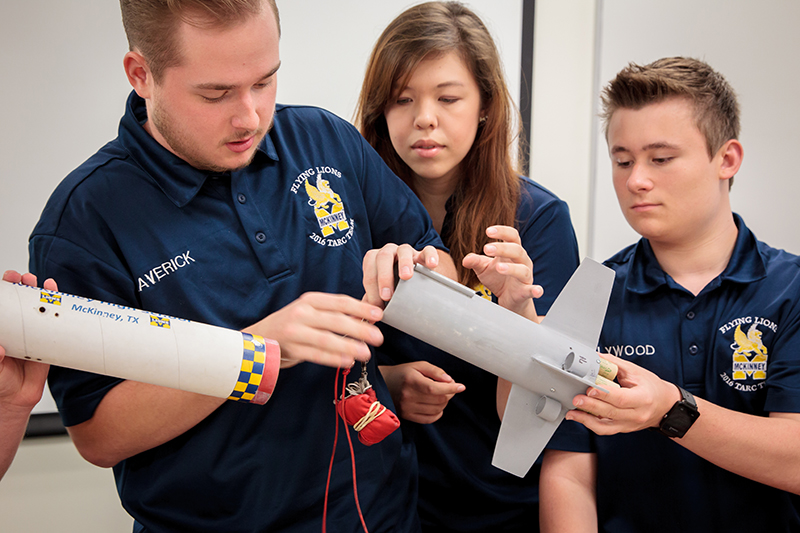
Team members William Slater, Kathryn Lehocky and Alex Lehocky demonstrate the procedure for loading the parachute as the team assembles their TARC rocket.
Peak – Round 1
The Team America Rocketry Challenge National Finals pitted the Flying Lions against 99 of the best rocketry teams in the country.
Standing at the launch pad on May 14 in The Plains, Virginia, about 50 miles west of Washington, D.C., the team was anxious. They had experienced the Rockets on the Hill event the day before that put them in contact with U.S. Senators and engineers from major companies and organizations. They had scouted the other teams and held their cards close to the vest when other teams scouted them.
But, it all came down to this—the team at the launch pad with the rocket they had designed and built. No guidance from Gupton or Lehocky, here. They were on their own.
The wind had them worried. Should they deploy the chute at 500 ft. or 600 ft.? Deploy too low, and the rocket would return too quickly and blow the time window. Deploy too high, and it would return too slowly.
There was little room for error.
They had to make a decision—500 ft. They were set up and ready to launch.
They signaled the judges.
Ignition.
When the smoke cleared, they found themselves in second place and qualified for the final round of 25 teams.
They had hit the specified altitude of 850 ft. exactly and missed the time window by only .71 seconds.
“We started jumping up and down and screaming and running,” said Kathryn.
They had already accomplished what no team from McKinney had ever accomplished—qualify for the final round at the TARC nationals.
On the line was $20,000 in prize money and an invitation to the 2017 NASA Student Launch Program.
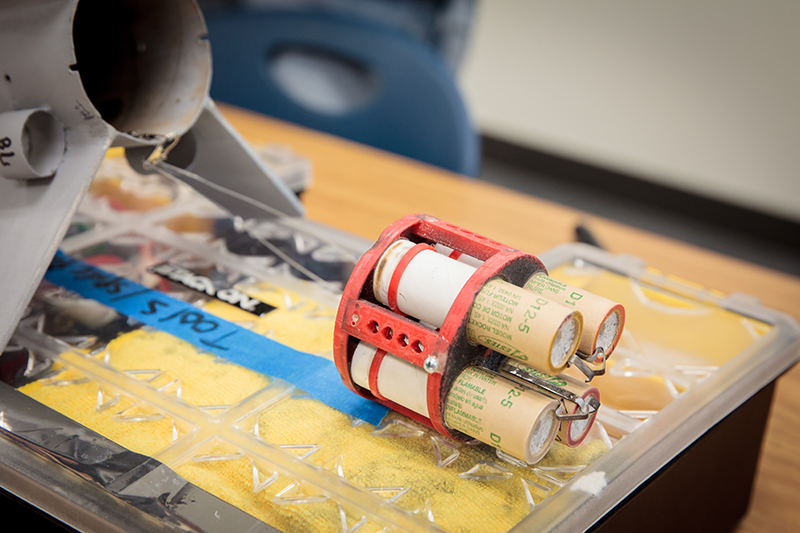
The team’s late entry into the 2016 TARC competition led to this engine cluster design after the team discovered a supply problem with the single engines used for their class of rocket. It would come back to haunt them.
Arc – Round 2
The storm was coming. They had to go.
Eric Beights, William Slater, Kathryn Lehocky, Alex Lehocky and Mitch Palmer stepped away from the rocket and signaled to the judges that they were ready to launch.
It was now or never.
Ignition.
It took about a second for something to go wrong. In a flash of flame and smoke, the rocket shot into the sky.
Immediately, it began to arc back over the crowd.
“I thought, ‘Well, there goes $20,000,’” remembered Will with a wry chuckle.
Standing in the rain, staring up at their dream arcing off course, the team knew that the rocket wouldn’t make its altitude. And that was going to ruin the time as well.
In spite of the poor weather conditions, it shouldn’t have done this. Something beyond their control had gone awry.
“We believe that one of the motors lit late because we were using a cluster,” said Will.
“Like, a few milliseconds late,” added Eric.
“So that caused a very wide parabolic arc,” said Will. “So, a) we didn’t get our height and b) since we didn’t get our height, we didn’t get our time because it came down faster. We ended up getting a height of 697 ft.—which is way below 825 ft.”
Their time was about 10 seconds under the window.
They finished 21st. In the nation.
And, they earned a spot at the 2017 NASA Student Launch program where students design rockets that are 6 in. in diameter, about 35 lbs. and 8 ft. in length and can reach an altitude of one mile.
Not bad for their first time out.
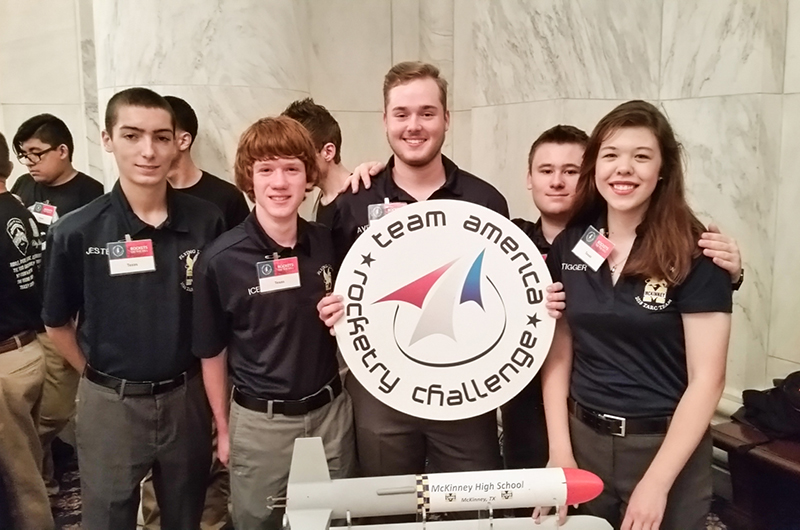
The 2016 McKinney High School Flying Lions TARC Team at the Rockets on the Hill event the night before the National Fly Off (l-r): Mitch Palmer, Eric Beights, William Slater, Alex Lehocky and Kathryn Lehocky
Aim High
“I’m very excited for them,” said Gupton. “I think they did a fantastic job. I think this is a small piece in their life, but I think it has actually made a huge change in their outlook and where they plan on going.
Lehocky, who helped guide the Flying Lions, was understandably proud of his daughter and the entire team—and gratified with the opportunities that the experience afforded them.
“Projects like TARC and NASA Student Launch give students practical hands on application of math, science and teamwork,” Lehocky said. “Students are faced with very difficult missions, and the solutions are not found in textbooks or even with mentors like myself. The students learn to find solutions that don’t fit in a nice perfect box. This requires a high degree of team work and team dynamics. When an unknown problem comes up, they have to work together using each person’s strengths to choose a course of action. This gives the students confidence in making decisions when they do not have a nice, controlled environment with text book answers.
“I am so proud of my daughter,” continued Lehocky. “The success in the competition was icing on the cake. But, as exciting as this year was, it is going to be nothing compared to next year. Because of the work done by Kathryn, Alex, Mitch, Will and Eric, the students have been invited to participate in the NASA Student Launch. Only a very small handful get invited. The students will basically receive a contract to build a high powered rocket for NASA, and they will have to perform every task from engineering, safety, budgeting and scheduling exactly like real engineers. That is an opportunity earned by this team through their hard work on the TARC project. When our students go to college and then look for their first engineering positions, they are going to be so far ahead of their peers because of this experience.”
Gupton is looking at starting three rocketry teams next year, including an all-girls team, and that sits well with Kathryn who returns as a senior for 2016–2017. “I think this year was a really good experience for me, and I would love other girls to do it. There’s a big need for girls in engineering. I’d love it for other girls to have the same experience that I had.”
As for the guys on the team, Will is off to the University of Texas next year where he’ll major in physics with his eye on a future in weapons engineering with a company like Lockheed-Martin or Raytheon. Mitch, Eric and Alex will all be seniors next year, and engineering is involved in some capacity in each of their plans beyond 2017.
“Even though we didn’t get in the top 10 like we wanted to this year,” said Mitch, “we did our best, and we got to nationals, so that’s always a huge accomplishment.”
And, the Flying Lions of McKinney High School are just getting started.
Need Help?
If you need additional assistance with the content on this page, please contact MISD Communications Department team member Shane Mauldin by phone at 469-302-4007 or by email here .
Press Contact
- [email protected]
- 469-302-4007
Recent News
- Molly Hovan Named MISD Executive Director of Elementary School Leadership
- Frazier 5th Grader Qualifies for 2024 National MathCON Finals for Second Consecutive Year
- Danielle Freeman from Frazier Elementary and Elias Kawesa from McKinney High School Named MISD Elementary and Secondary Teachers of the Year